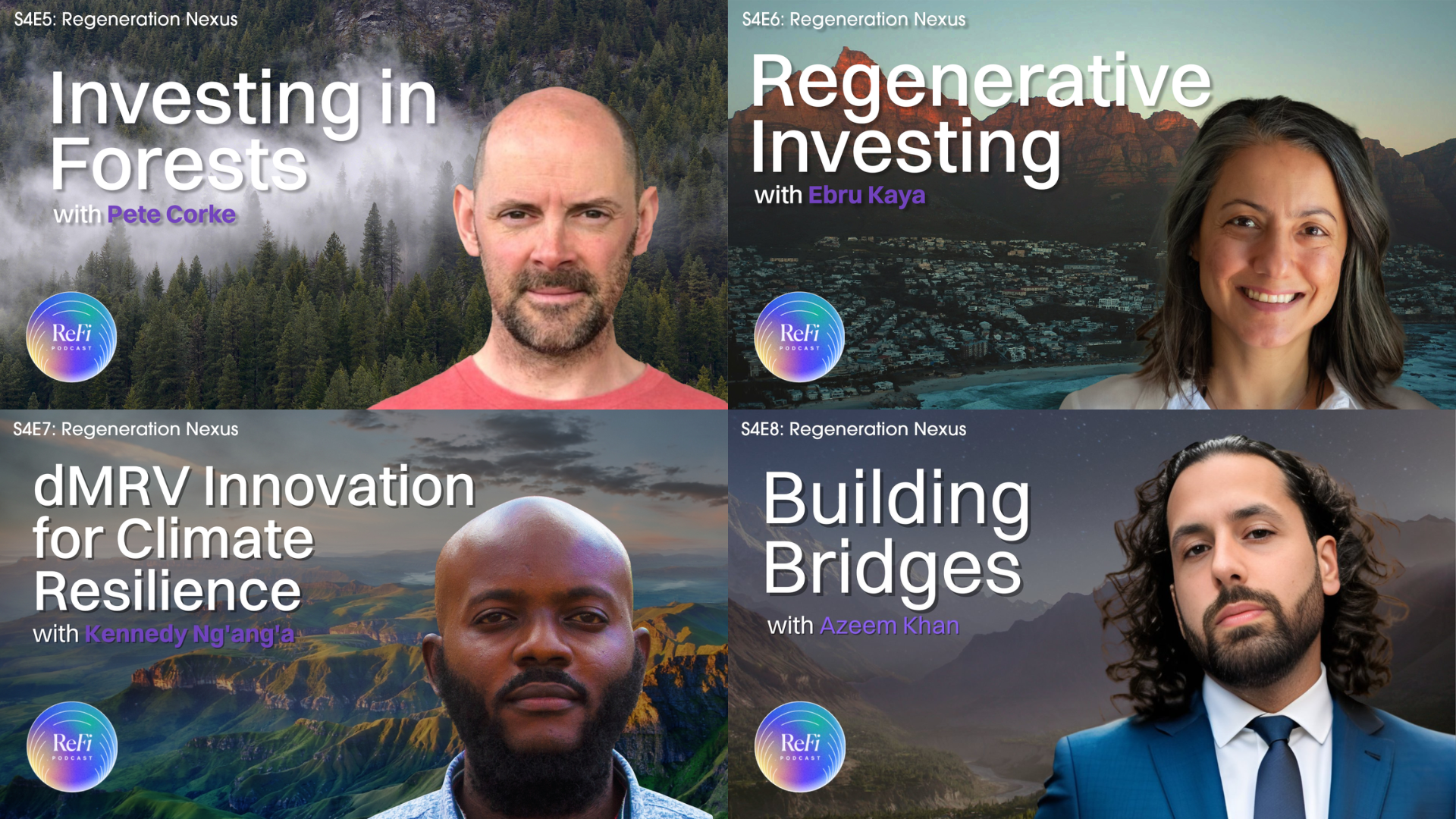Reflections on the Second ReFi Podcast S4 Miniseries: Exploring Real-World Impact 🌍🎙️

We’re excited to wrap up the second miniseries of Season 4 of The Regeneration Nexus, “The Practice: What does effective regenerative change look like in the real world?” This series focused on translating ideas into action, exploring the tools, systems, and relationships that make real-world impact possible.
Across four episodes, our guests—Pete Corke, Ebru Kaya, Kennedy Ng’ang’a, and Azeem Khan—shared how they are bridging innovation with local realities, redesigning extractive systems, and empowering communities to lead regeneration.
Recurring themes emerged throughout: integrating traditional knowledge with decentralized tools, aligning financial incentives with ecological stewardship, and respecting cultural and environmental contexts.
From rethinking how we value forests to crafting regenerative investment strategies, these conversations underscored that effective change relies on collaboration, inclusivity, and systems designed for regeneration, not extraction.

💡 Key Themes
Throughout these conversations, several key themes emerged, answering the guiding question: What Does Effective Regenerative Change Look Like in Practice?
🌲 Our current economic system is designed to extract
Pete Corke illustrated how our current economic system is fundamentally designed for extraction, treating the preservation of natural systems like living forests as liabilities rather than assets.
This is driven by debt-based financial systems, which perpetuate a growth imperative that incentivizes destruction. A regenerative approach flips this formula: by purchasing extraction rights and converting them into regenerative assets, we can design systems that hold and protect the value of nature.

Tune in to Pete's Episode. 👇
🧠 We need to balance logic and context in investing
Ebru Kaya highlighted that regenerative investing goes beyond traditional impact investing by integrating deeper systemic principles. It starts with understanding the essence of a business, its entrepreneur, and the local context to ensure alignment with the ecosystem’s unique potential. This approach emphasizes citizenship—nurturing the environment and recognizing that thriving ecosystems enable flourishing businesses.
Regenerative investing also seeks a balance between left-hemisphere logic—focused on analysis and efficiency—and right-hemisphere thinking, which values context, relationships, and holistic understanding. Blending assertive (competitive) and integrative (collaborative) tendencies aligns financial strategies with the living systems of nature.
The result is investments that not only deliver financial returns but also foster harmony, regeneration, and thriving ecosystems.

Tune in to Ebru's Episode. 👇
📡 Technology is powerless unless it meets communities where they are
Kennedy Ng’ang’a emphasized that technology is most impactful when it is grounded in local realities and designed to give communities control over its use. Tools like blockchain and satellite data can measure ecological contributions such as reforestation or soil health, but their effectiveness depends on being accessible and tailored to local needs.
The real power of these tools lies in community ownership. When communities can shape how technologies are used and directly benefit from the outcomes, they become active drivers of regeneration, creating lasting impact and fostering a deeper connection to the ecosystems they depend on.

Tune in to Kennedy's Episode. 👇
🌉 Building bridges matters, not burning them
Azeem Khan emphasized that Web3’s ability to realize its potential lies in building bridges between traditional systems and decentralized innovation, rather than disrupting for the sake of change. By combining established methods with emerging technologies, Web3 can align incentives to create ecosystems where financial success drives social impact.
Sustainable progress depends on systems that actively regenerate resources and reward collaboration, shifting away from reliance on charity or speculation. To achieve this, we must focus on developing mechanisms that embed such principles.

Tune in to Azeem's Episode. 👇
👀 What’s Next?
In the third miniseries, “The Tools: How can technological advances enhance and scale regenerative vision?” we’ll explore how emerging technologies like blockchain, satellite data, and Web3 tools are being used to drive regeneration.
This series will focus on practical examples of how technology can support ecological restoration, empower communities, and align financial systems with regeneration. We’ll look at how these tools can measure impact, bridge traditional systems with decentralized innovation, and create meaningful change at scale.
Join us as we unpack how technology is being used effectively to support a regenerative future and hear from those making it happen. Stay tuned! 🚀
🎧 Listen to Season 4 now on your favorite platform:
🙏 Support Us
Help us grow the ReFi Podcast and reach even more listeners! You can directly support our work by contributing on Giveth or simply buy us a coffee to fuel the journey. Your support, no matter how small, makes a big impact. 🙌
Thank you for being part of this journey toward a regenerative future! 💜

